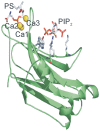Phosphatidylinositol 4,5-bisphosphate decreases the concentration of Ca2+, phosphatidylserine and diacylglycerol required for protein kinase C α to reach maximum activity
- PMID: 23874859
- PMCID: PMC3707892
- DOI: 10.1371/journal.pone.0069041
Phosphatidylinositol 4,5-bisphosphate decreases the concentration of Ca2+, phosphatidylserine and diacylglycerol required for protein kinase C α to reach maximum activity
Abstract
The C2 domain of PKCα possesses two different binding sites, one for Ca(2+) and phosphatidylserine and a second one that binds PIP2 with very high affinity. The enzymatic activity of PKCα was studied by activating it with large unilamellar lipid vesicles, varying the concentration of Ca(2+) and the contents of dioleylglycerol (DOG), phosphatidylinositol 4,5-bisphosphate (PIP2) and phosphadidylserine (POPS) in these model membranes. The results showed that PIP2 increased the Vmax of PKCα and, when the PIP2 concentration was 5 mol% of the total lipid in the membrane, the addition of 2 mol% of DOG did not increase the activity. In addition PIP2 decreases K0.5 of Ca(2+) more than 3-fold, that of DOG almost 5-fold and that of POPS by a half. The K0.5 values of PIP2 amounted to only 0.11 µM in the presence of DOG and 0.39 in its absence, which is within the expected physiological range for the inner monolayer of a mammalian plasma membrane. As a consequence, PKCα may be expected to operate near its maximum capacity even in the absence of a cell signal producing diacylglycerol. Nevertheless, we have shown that the presence of DOG may also help, since the K0.5 for PIP2 notably decreases in its presence. Taken together, these results underline the great importance of PIP2 in the activation of PKCα and demonstrate that in its presence, the most important cell signal for triggering the activity of this enzyme is the increase in the concentration of cytoplasmic Ca(2+).
Conflict of interest statement
Figures





Similar articles
-
Specific translocation of protein kinase Calpha to the plasma membrane requires both Ca2+ and PIP2 recognition by its C2 domain.Mol Biol Cell. 2006 Jan;17(1):56-66. doi: 10.1091/mbc.e05-06-0499. Epub 2005 Oct 19. Mol Biol Cell. 2006. PMID: 16236797 Free PMC article.
-
Phosphatidylinositol-4,5-bisphosphate enhances anionic lipid demixing by the C2 domain of PKCα.PLoS One. 2014 Apr 24;9(4):e95973. doi: 10.1371/journal.pone.0095973. eCollection 2014. PLoS One. 2014. PMID: 24763383 Free PMC article.
-
Mechanism of specific membrane targeting by C2 domains: localized pools of target lipids enhance Ca2+ affinity.Biochemistry. 2007 Apr 10;46(14):4322-36. doi: 10.1021/bi062140c. Epub 2007 Mar 17. Biochemistry. 2007. PMID: 17367165 Free PMC article.
-
Effect of PIP2 binding on the membrane docking geometry of PKC alpha C2 domain: an EPR site-directed spin-labeling and relaxation study.Biochemistry. 2008 Aug 12;47(32):8301-16. doi: 10.1021/bi800711t. Epub 2008 Jul 9. Biochemistry. 2008. PMID: 18610985 Free PMC article.
-
Receptor-mediated signalling pathways acting through hydrolysis of membrane phospholipids in cardiomyocytes.Cardioscience. 1993 Sep;4(3):121-31. Cardioscience. 1993. PMID: 8400019 Review.
Cited by
-
Protein Kinase Cα (PKCα) Is Resistant to Long Term Desensitization/Down-regulation by Prolonged Diacylglycerol Stimulation.J Biol Chem. 2016 Mar 18;291(12):6331-46. doi: 10.1074/jbc.M115.696211. Epub 2016 Jan 14. J Biol Chem. 2016. PMID: 26769967 Free PMC article.
-
Single-molecule studies reveal a hidden key step in the activation mechanism of membrane-bound protein kinase C-α.Biochemistry. 2014 Mar 18;53(10):1697-713. doi: 10.1021/bi4016082. Epub 2014 Mar 7. Biochemistry. 2014. PMID: 24559055 Free PMC article.
-
Unfair competition governs the interaction of pCPI-17 with myosin phosphatase (PP1-MYPT1).Elife. 2017 Apr 7;6:e24665. doi: 10.7554/eLife.24665. Elife. 2017. PMID: 28387646 Free PMC article.
-
Classical protein kinases C are regulated by concerted interaction with lipids: the importance of phosphatidylinositol-4,5-bisphosphate.Biophys Rev. 2014 Mar;6(1):3-14. doi: 10.1007/s12551-013-0125-z. Epub 2013 Nov 27. Biophys Rev. 2014. PMID: 28509956 Free PMC article. Review.
-
Calcium Stimulates Self-Assembly of Protein Kinase C α In Vitro.PLoS One. 2016 Oct 5;11(10):e0162331. doi: 10.1371/journal.pone.0162331. eCollection 2016. PLoS One. 2016. PMID: 27706148 Free PMC article.
References
-
- Corbalan-Garcia S, Gomez-Fernandez JC (2006) Protein kinase C regulatory domains: the art of decoding many different signals in membranes. Biochim Biophys Acta 1761: 633–654. - PubMed
-
- Nishizuka Y (1995) Protein kinase C and lipid signaling for sustained cellular responses. FASEB J 9: 484–496. - PubMed
-
- Corbalan-Garcia S, Garcia-Garcia J, Rodriguez-Alfaro JA, Gomez-Fernandez JC (2003) A new phosphatidylinositol 4,5-bisphosphate-binding site located in the C2 domain of protein kinase Calpha. J Biol Chem 278: 4972–4980. - PubMed
-
- Guerrero-Valero M, Marin-Vicente C, Gomez-Fernandez JC, Corbalan-Garcia S (2007) The C2 domains of classical PKCs are specific PtdIns(4,5)P2-sensing domains with different affinities for membrane binding. J Mol Biol 371: 608–621. - PubMed
-
- Marin-Vicente C, Nicolas FE, Gomez-Fernandez JC, Corbalan-Garcia S (2008) The PtdIns(4,5)P2 ligand itself influences the localization of PKCalpha in the plasma membrane of intact living cells. J Mol Biol 377: 1038–1052. - PubMed
Publication types
MeSH terms
Substances
LinkOut - more resources
Full Text Sources
Other Literature Sources
Research Materials
Miscellaneous

